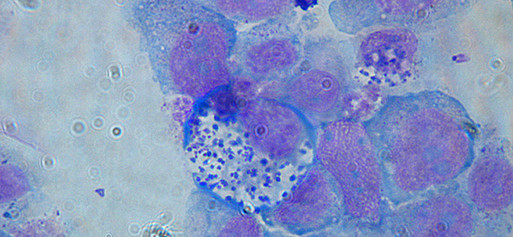Genetic variability and immunological control of Anaplasma phagocytophilum (von Loewenich Laboratory)
Current Research
Genetic variability of Anaplasma phagocytophilum
Anaplasma phagocytophilum is an obligat intracellular bacterium that replicates in neutrophil granulocytes and causes febrile disease in humans and animals. In Europe, it is transmitted by Ixodes ricinus ticks. It In contrast to North America, human granulocytic anaplasmosis is a rare disease in Europe. Further, cross-infection experiments showed that A. phagocytophilum isolates of distinct host origin are not uniformly infectious for heterologous hosts. This led to several approaches of genetic characterization of A. phagocytophilum strains looking for molecular markers that could be associated with geographic origin or host species.Since a variety of target genes was used previously, we developed a standardized multilocus sequence typing (MLST) scheme for A. phagocytophilum (http://pubmlst.org/). We could show that all strains from humans, dogs and horses belonged to the same clonal complex. Since granulocytic anaplasmosis in these animals is often diagnosed in Europe, most human cases might not be recognized. We currently characterize further strains by means of MLST and try to sequence whole genomes.
Immunological control of Anaplasma phagocytophilum
Since A. phagocytophilum replicates in a main cell of the innate immune system, it is used as model organism to study the immunological control of obligat intracellular pathogens. We showed using the mouse model that the control in the early phase of infection is IFNγ-dependent. In contrast, CD4+ T-cells are indispensable for bacterial elimination. To date, the effector mechanisms used by CD4+ T-cells are unclear because mice with defects for Th1 cytokines, perforin and Fas/Fas ligand were fully able to clear the infection. Therefore, we are studying in vitro whether a direct interaction between CD4+ T-cells and A. phagocytophilum infected granulocytes inhibits bacterial replication. For this purpose we use in vitro generated murine neutrophil granulocytes. Further, we use granulocytes defective for MHC I and MHC II to analyze whether antigen presentation by neutrophils is need for CD4+ T-cell dependent control. Respective genedeficient cell lines are used to study whether neutrophils itself contribute to the defense against A. phagocytophilum.
Members
Publications
2023Kruppenbacher AS, Müller E, Aardema ML, Schäfer I, von Loewenich FD (2023) Granulocytic anaplasmosis in cats from central Europe and molecular characterization of feline Anaplasma phagocytophilum strains by ankA gene, groEL gene and multilocus sequence typing. Parasit Vectors 16:348. doi: 10.1186/s13071-023-05954-3.
2022
Aardema ML, Bates NV, Archer QE, von Loewenich FD (2022) Demographic Expansions and the Emergence of Host Specialization in Genetically Distinct Ecotypes of the Tick-Transmitted Bacterium Anaplasma phagocytophilum. Appl Environ Microbiol 88:e0061722. doi: 10.1128/aem.00617-22.
Müller-Heupt LK, Vierengel N, Groß J, Opatz T, Deschner J, von Loewenich FD (2022) Antimicrobial Activity of Eucalyptus globulus, Azadirachta indica, Glycyrrhiza glabra, Rheum palmatum Extracts and Rhein against Porphyromonas gingivalis. Antibiotics 31:186. doi: 10.3390/antibiotics11020186.
Vaca DJ, Dobler G, Fischer SF, Keller C, Konrad M, von Loewenich FD, Orenga S, Sapre SU, van Belkum A, Kempf VAJ (2022) Contemporary diagnostics for medically relevant fastidious microorganisms belonging to the genera Anaplasma, Bartonella, Coxiella, Orientia and Rickettsia. FEMS Microbiol Rev. 46:fuac013. doi: 10.1093/femsre/fuac013.
2021
Müller BJ, Westheider A, Birkner K, Seelig B, Kirschnek S, Bogdan C, von Loewenich FD (2021) Anaplasma phagocytophilum Induces TLR- and MyD88-Dependent Signaling in In Vitro Generated Murine Neutrophils. Front Cell Infect Microbiol. 11:627630. doi: 10.3389/fcimb.2021.627630.
2020
Langenwalder DB, Schmidt S, Silaghi C, Skuballa J, Pantchev N, Matei IA, Mihalca AD, Gilli U, Zajkowska J, Ganter M, Hoffman T, Salaneck E, Petrovec M, von Loewenich FD (2020) The absence of the drhm gene is not a marker for human-pathogenicity in European Anaplasma phagocytophilum strains. Parasit Vectors. 13:238. doi: 10.1186/s13071-020-04116-z.
Hoffman T, Wilhelmsson P, Barboutis C, Fransson T, Jaenson TGT, Lindgren PE, von Loewenich FD, Lundkvist Å, Olsen B, Salaneck E (2020) A divergent Anaplasma phagocytophilum variant in an Ixodes tick from a migratory bird; Mediterranean basin. Infect Ecol Epidemiol. 10:1729653. doi: 10.1080/20008686.2020.1729653.
Langenwalder DB, Silaghi C, Nieder M, Pfeffer M, von Loewenich FD (2020) Co-infection, reinfection and superinfection with Anaplasma phagocytophilum strains in a cattle herd based on ankA gene and multilocus sequence typing. Parasit Vectors. 13:157. doi: 10.1186/s13071-020-04032-2.
Mukhacheva TA, Shaikhova DR, Kovalev SY, von Loewenich FD (2020) Phylogeographical diversity of Anaplasma phagocytophilum in the Asian part of Russia based on multilocus sequence typing and analysis of the ankA gene. Infect Genet Evol. 80:104234. doi: 10.1016/j.meegid.2020.104234.
2019
von Loewenich FD, Seckert C, Dauber E, Kik MJL, de Vries A, Sprong H, Buschmann K, Aardema ML, Brandstetter M (2019) Prosthetic Valve Endocarditis with Bartonella washoensis in a Human European Patient and Its Detection in Red Squirrels ( Sciurus vulgaris). J Clin Microbiol. 58:e01404-19. doi: 10.1128/JCM.01404-19.
Langenwalder DB, Schmidt S, Gilli U, Pantchev N, Ganter M, Silaghi C, Aardema ML, von Loewenich FD (2019) Genetic characterization of Anaplasma phagocytophilum strains from goats (Capra aegagrus hircus) and water buffalo (Bubalus bubalis) by 16S rRNA gene, ankA gene and multilocus sequence typing. Ticks Tick Borne Dis. 10:101267. doi: 10.1016/j.ttbdis.2019.101267.
Tegtmeyer P, Ganter M, von Loewenich FD (2019) Simultaneous infection of cattle with different Anaplasma phagocytophilum variants. Ticks Tick Borne Dis. 10:1051. doi: 10.1016/j.ttbdis.2019.05.011.
2017
Gussmann K, Kirschnek S, von Loewenich FD. Interferon-γ-dependent control of Anaplasma phagocytophilum by murine neutrophil granulocytes (2017) Parasit Vectors.10:329. doi: 10.1186/s13071-017-2274-6.
Silaghi C, Santos AS, Gomes J, Christova I, Matei IA, Walder G, Domingos A, Bell-Sakyi L, Sprong H, von Loewenich FD, Oteo JA, de la Fuente J, Dumler JS (2017) Guidelines for the Direct Detection of Anaplasma spp. in Diagnosis and Epidemiological Studies. Vector Borne Zoonotic Dis. 17:12. doi: 10.1089/vbz.2016.1960.
2015
Aardema ML, von Loewenich FD (2015) Varying influences of selection and demography in host-adapted populations of the tick-transmitted bacterium, Anaplasma phagocytophilum. BMC Evol Biol. 15:58. doi: 10.1186/s12862-015-0335-z.
Strašek Smrdel K, von Loewenich FD, Petrovec M, Avšič Županc T. Diversity of ankA and msp4 genes of Anaplasma phagocytophilum in Slovenia (2015) Ticks Tick Borne Dis. 6:164. doi: 10.1016/j.ttbdis.2014.11.008.
2014
Gussmann K, Czech C, Hermann M, Schaarschmidt-Kiener D, von Loewenich FD (2014) Anaplasma phagocytophilum infection in a horse from Switzerland with severe neurological symptoms. Schweiz Arch Tierheilkd. 156:345. doi: 10.1024/0036-7281/a000605.
Huhn C, Winter C, Wolfsperger T, Wüppenhorst N, Strašek Smrdel K, Skuballa J, Pfäffle M, Petney T, Silaghi C, Dyachenko V, Pantchev N, Straubinger RK, Schaarschmidt-Kiener D, Ganter M, Aardema ML, von Loewenich FD (2014) Analysis of the population structure of Anaplasma phagocytophilum using multilocus sequence typing. PLoS One 9:e93725. doi: 10.1371/journal.pone.0093725.
Härtwig V, von Loewenich FD, Schulze C, Straubinger RK, Daugschies A, Dyachenko V. Detection of Anaplasma phagocytophilum in red foxes (Vulpes vulpes) and raccoon dogs (Nyctereutes procyonoides) from Brandenburg, Germany (2014) Ticks Tick Borne Dis. 5:277. doi: 10.1016/j.ttbdis.2013.11.001.
2013
Majazki J, Wüppenhorst N, Hartelt K, Birtles R, von Loewenich FD (2013) Anaplasma phagocytophilum strains from voles and shrews exhibit specific ankA gene sequences. BMC Vet Res. 9:235. doi: 10.1186/1746-6148-9-235.
Henniger T, Henniger P, Grossmann T, Distl O, Ganter M, von Loewenich FD. Congenital infection with Anaplasma phagocytophilum in a calf in northern Germany (2013). Acta Vet Scand. 55:38. doi: 10.1186/1751-0147-55-38.
2011
Liesenfeld O, Parvanova I, Zerrahn J, Han SJ, Heinrich F, Muñoz M, Kaiser F, Aebischer T, Buch T, Waisman A, Reichmann G, Utermöhlen O, von Stebut E, von Loewenich FD, Bogdan C, Specht S, Saeftel M, Hoerauf A, Mota MM, Könen-Waisman S, Kaufmann SH, Howard JC. (2011) The IFN-γ-inducible GTPase, Irga6, protects mice against Toxoplasma gondii but not against Plasmodium berghei and some other intracellular pathogens. PLoS One. 6:e20568. doi: 10.1371/journal.pone.0020568.
Scharf W, Schauer S, Freyburger F, Petrovec M, Schaarschmidt-Kiener D, Liebisch G, Runge M, Ganter M, Kehl A, Dumler JS, Garcia-Perez AL, Jensen J, Fingerle V, Meli ML, Ensser A, Stuen S, von Loewenich FD (2011) Distinct host species correlate with Anaplasma phagocytophilum ankA gene clusters. J Clin Microbiol. 49:790-6. doi: 10.1128/JCM.02051-10.
2010
Stuen S, Scharf W, Schauer S, Freyburger F, Bergström K, von Loewenich FD (2010) Experimental infection in lambs with a red deer (Cervus elaphus) isolate of Anaplasma phagocytophilum. J Wildl Dis. 46:803. doi: 10.7589/0090-3558-46.3.803.
von Loewenich FD, Geissdörfer W, Disqué C, Matten J, Schett G, Sakka SG, Bogdan C (2010) Detection of "Candidatus Neoehrlichia mikurensis" in two patients with severe febrile illnesses: evidence for a European sequence variant. J Clin Microbiol. 48:2630. doi: 10.1128/JCM.00588-10.
Bussmeyer U, Sarkar A, Broszat K, Lüdemann T, Möller S, van Zandbergen G, Bogdan C, Behnen M, Dumler JS, von Loewenich FD, Solbach W, Laskay T (2010) Impairment of gamma interferon signaling in human neutrophils infected with Anaplasma phagocytophilum. Infect Immun.78:358. doi: 10.1128/IAI.01005-09.
2005
de la Fuente J, Massung RF, Wong SJ, Chu FK, Lutz H, Meli M, von Loewenich FD, Grzeszczuk A, Torina A, Caracappa S, Mangold AJ, Naranjo V, Stuen S, Kocan KM (2005) Sequence analysis of the msp4 gene of Anaplasma phagocytophilum strains. J Clin Microbiol. 43:1309. doi: 10.1128/JCM.43.3.1309-1317.
2004
von Loewenich FD, Scorpio DG, Reischl U, Dumler JS, Bogdan C (2004) Frontline: control of Anaplasma phagocytophilum, an obligate intracellular pathogen, in the absence of inducible nitric oxide synthase, phagocyte NADPH oxidase, tumor necrosis factor, Toll-like receptor (TLR)2 and TLR4, or the TLR adaptor molecule MyD88. Eur J Immunol. 34:1789. doi: 10.1002/eji.200425029.
2003
von Loewenich FD, Baumgarten BU, Schröppel K, Geissdörfer W, Röllinghoff M, Bogdan C (2003) High diversity of ankA sequences of Anaplasma phagocytophilum among Ixodes ricinus ticks in Germany. J Clin Microbiol. 41:5033. doi: 10.1128/JCM.41.11.5033-5040.2003.
von Loewenich FD, Stumpf G, Baumgarten BU, Röllinghoff M, Dumler JS, Bogdan C (2003) A case of equine granulocytic ehrlichiosis provides molecular evidence for the presence of pathogenic anaplasma phagocytophilum (HGE agent) in Germany. Eur J Clin Microbiol Infect Dis. 22:303. doi: 10.1007/s10096-003-0935-1.
For more publications see here
